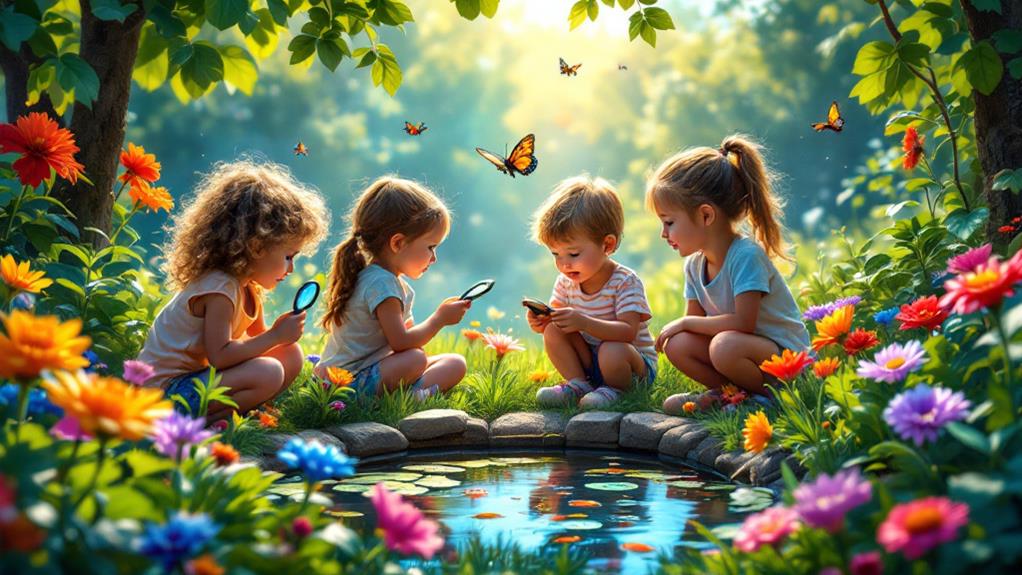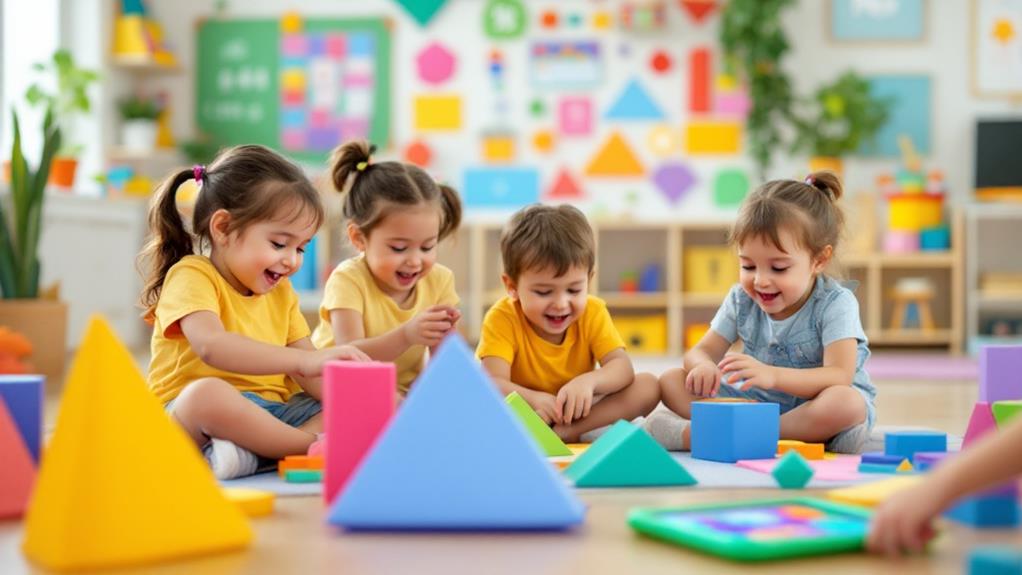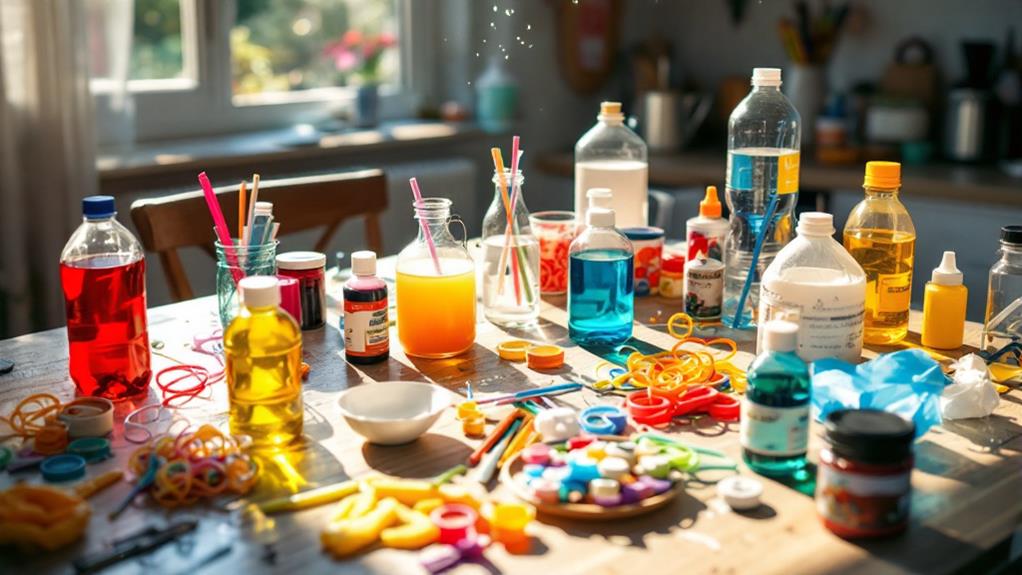Fun Science Ideas for Kids: Experiments and Activities to Inspire Young Minds

Ignite your child's curiosity with fun science experiments and engaging activities! Start with colorful chemistry using red cabbage juice to reveal pH mysteries or create a lively rainbow in a jar. Investigate physics by building a gravity ramp with marbles to illustrate motion. Encourage a green thumb by observing the life cycle of plants or create a mini ecosystem with a terrarium. Immerse yourself in the cosmos with a baking soda rocket or investigate engineering by constructing catapults from household items. Transform math into an adventure with interactive games and scavenger hunts. Stay tuned for more exciting experiments to examine.
Colorful Chemistry Reactions
Immerse yourself in a world of lively hues and magical transformations with colorful chemistry reactions! You'll uncover the wonders of color mixing and the intriguing effects of pH indicators. Begin with a simple experiment using red cabbage juice, a natural pH indicator. Boil the cabbage leaves, and you'll get a vivid purple liquid. Pour this into several clear cups and add different household substances like vinegar, baking soda, and lemon juice. Watch in amazement as the colors change, revealing if the solutions are acidic or basic.
Another exciting way to investigate color mixing is by creating a rainbow in a jar. Fill a glass halfway with water, adding a few drops of food coloring. Carefully layer liquids of varying densities, such as dish soap and vegetable oil, on top. As you add each layer, you'll see a beautiful spectrum emerge. This experiment demonstrates how different substances interact and how density affects the outcome.
These colorful chemistry reactions aren't just visually enchanting; they also teach you valuable scientific concepts. You're not only observing chemical changes but also understanding the principles behind them. Immerse yourself in these experiments, and let your curiosity lead the way!
Simple Physics Experiments
When you're ready to immerse yourself in the wonders of physics, simple experiments can reveal the fascinating principles at play in our everyday world. It's thrilling to see how basic concepts like gravity and motion shape the environment around us. With a few household items, you can engage in gravity games and motion marbles that both educate and entertain.
Begin with a gravity game by creating a simple ramp using a piece of cardboard. Prop one end higher than the other and let marbles roll down. Observe how gravity pulls the marbles, causing them to accelerate. Notice how the height of the ramp affects the speed and distance the marbles travel. This is a fun way to see gravity's influence firsthand.
Next, investigate motion marbles by setting up a chain reaction. Line up several marbles in a straight line on a flat surface. Gently push the initial marble into the line and watch the transfer of motion from one marble to the next. This illustrates Newton's third law of motion: for every action, there's an equal and opposite reaction.
These engaging experiments allow you to experience the compelling world of physics right at home.
Fun Biology Adventures

How can you investigate the wonders of biology without stepping into a lab? Start with a backyard or a nearby park! Observing plant growth is an exciting way to examine biology. Gather some seeds like beans or sunflowers, plant them in small pots, and watch as they sprout and grow. Keep a journal to record their progress, noting factors like sunlight and water, and see how these affect the speed and health of your plants. This hands-on approach lets you witness life cycles directly.
Next, investigate animal habitats by creating a mini ecosystem in a terrarium. Find a clear container and add layers of soil, rocks, and moss. Introduce small insects like ants or beetles, and observe how they interact with their environment. You'll get to see how they create tunnels, forage for food, and maintain their habitat. This micro-world offers insights into larger ecosystems and the delicate balance of nature.
Venturing into nature to examine plant growth and animal habitats not only sparks curiosity but also fosters an appreciation for the living world around you. These fun biology adventures make science accessible and engaging, right from your doorstep.
Exploring Earth Science
Earth science offers countless opportunities for exploration right in your backyard. Grab a small shovel and start digging to uncover the fascinating world of soil composition. As you dig, observe the colors, textures, and even the smell of the soil. You'll find that soil isn't just dirt; it's a mix of minerals, organic matter, and living organisms. Try collecting samples from different spots and compare them. Is the soil near the garden different from the soil under the trees? Understanding soil composition helps you learn about the environment and how plants grow.
Next, shift your focus to rock identification. Rocks are all around you, and each one has a story to tell. Head to a local park or your own backyard and start collecting diverse rocks. Look closely at their colors, patterns, and textures. Are they smooth or rough? Do they have stripes or speckles? Use a rock identification guidebook or smartphone app to help identify if you've found igneous, sedimentary, or metamorphic rocks. This hands-on activity will improve your observation skills and deepen your appreciation for Earth's geological processes. Who knew exploring earth science could be so exciting and educational?
DIY Space Projects

Curiosity can launch you into the wonders of space right from your living room. Immerse yourself in the excitement of DIY space projects with your kids and investigate fascinating concepts like rocket launches and moon phases. Start by crafting a simple baking soda and vinegar rocket. Collect an empty film canister, fill it with a small amount of vinegar, and add a teaspoon of baking soda. Quickly seal the canister and watch the fun unfold as it launches skyward, simulating a real rocket's takeoff. This hands-on activity demonstrates the basics of chemical reactions and thrust.
Next, probe into the mystery of moon phases with a simple yet engaging project using a flashlight and a ball. Darken the room, shine the flashlight on the ball, and rotate it around a central position to mimic the moon's orbit around Earth. You'll see how the changing light on the ball reflects the different moon phases we observe each month. This visual representation helps kids grasp why the moon looks different at distinct times.
These DIY space projects offer a fantastic way to engage young minds, encouraging investigation and revelation right at home.
Creative Engineering Challenges
Imagination fuels the excitement of creative engineering challenges for kids, transforming everyday materials into extraordinary inventions. Picture your child's wonder as they initiate a bridge building adventure, using popsicle sticks and glue to create a structure that can hold weight. It's a hands-on way to learn about balance and design.
Next, challenge them with a catapult challenge. Using spoons, rubber bands, and a little ingenuity, they'll uncover how tension and angles can launch marshmallows across the room. It's a playful introduction to physics.
For something more daring, try the egg drop experiment. Encourage them to engineer a contraption that can protect an egg from a high fall. This task sparks creativity and problem-solving skills, as they test and refine their designs.
Launch into the sky with water rockets, where simple materials like plastic bottles and water become vessels for flight. In the same way, balloon cars and rubber band racers transform air and elastic energy into motion, teaching propulsion concepts.
Lastly, paper airplanes and tower construction offer endless opportunities for experimentation. From aerodynamic designs to towering structures, these projects foster learning through play, ensuring young minds remain engaged and inspired.
Interactive Math Games

Step into the world of interactive math games, where learning becomes an adventure that's both educational and engaging. Imagine turning your home or classroom into a playground of numbers and equations. Start with a math scavenger hunt, where you can hide numbers around the room and challenge kids to solve puzzles to find them. It's a fun way to reinforce math concepts like summation and subtraction while keeping children on their toes.
Number line activities can also be a great way to make math more interactive. Create a giant number line on the floor using tape, and let kids physically jump to different numbers. You can call out math problems, and they'll have to solve them by jumping to the correct answer. This physical activity not only helps with understanding number sequences but also adds an element of excitement and movement to math learning.
With interactive math games, you're not just teaching math; you're making it come alive. Kids will love the thrill of exploration and the satisfaction of solving problems in creative ways. So grab those markers, tape, and numbers, and transform math into a delightful expedition today!
Nature-Based Science Activities
Nature's classroom offers endless opportunities for engaging science activities that captivate kids' curiosity and wonder. One exciting way to plunge into the natural world is through nature scavenger hunts. With a simple list of items like unique leaves, acorns, or interesting rocks, you can guide kids on a thrilling adventure. As they investigate, they'll learn to observe, identify, and appreciate the diversity around them. This hands-on approach not only sharpens their observation skills but also fosters a deeper connection with nature.
Another fascinating activity is conducting plant growth experiments. You don't need a fancy lab to teach kids about the life cycle of plants. Start with seeds, some soil, and small pots. Kids can plant the seeds and observe how different conditions like sunlight, water, and soil type affect growth. Encourage them to keep a journal documenting changes, drawing pictures, and predicting outcomes. This experiment teaches patience and the scientific method as they hypothesize and draw insights from their observations.
Both nature scavenger hunts and plant growth experiments provide valuable lessons in biology and environmental science. By immersing kids in nature-based activities, you inspire a lifelong love of learning and exploration.



